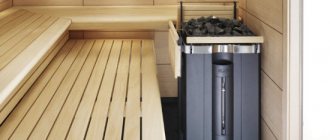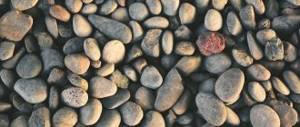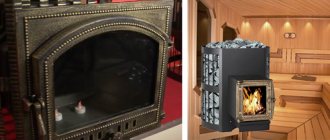Properties of soapmagnesite
Soap stone, hot stone, pot stone, mammoth stone, soapstone - all these are names for one material of natural origin, unique in its properties, namely soapstone.
Hot stone, so popular today, contains a centuries-old history. Almost 3 million years ago, magnesium-containing lava erupted from the depths of the earth, which was carried away from the eruption site by underwater currents. The cooled mineral composition was crushed by continental plates, after which it was subjected to melting and pressing for a long time.
Talkomagnesite: stone texture
As a result, a valuable rock called “Talcomagnesite slate” appeared with amazing properties:
- thermal conductivity. The stone quickly and evenly accumulates heat, after which it can release it for a long time. Thus, after the heating process in a soapstone stove or fireplace is completed, a comfortable temperature in the room will be maintained for up to 36 hours. It’s not difficult to guess how long fireplace stoves with soapstone lining retain heat; of course, such stoves cool down a little faster, but are capable of warming up a room for up to 24 hours;
- heat capacity or the ability to accumulate heat. Talkomagnesite can withstand temperatures up to 1600°C and is 2-3 times higher in heat capacity than kiln brick;
- high density. Due to low porosity and minimal amount of water in the composition. Due to this property, moisture and chemicals do not penetrate deep into the stone, which makes it possible to use this material in damp rooms and clean it by any means;
- strength. Stone products withstand temperature fluctuations; soapstone does not melt or fade;
- ductility or bending strength. Easy to process due to the presence of soft chlorite in the composition.
In addition, hot stone is famous for its healing properties - it produces soft heat that is beneficial for health. There is an opinion that this mineral has special energy; it is used for the prevention and treatment of radiculitis, osteochondrosis, sciatica and joint damage. Therefore, you can often find biostimulants made from soapstone magnesite on sale.
The properties of this rock allow potting stone to be widely used in the production of stoves and fireplaces, it is used as part of facing slabs and floor coverings, the material is also suitable for constructing bathrooms, swimming pools, saunas and verandas, you can even find dishes, grill boards and other items from soapstone.
This rock is mined in Finland and Karelia. And, if the Finns usually use soapstone magnesite in the production of stoves and fireplaces, then in Karelia they also mine a similar rock - soapstone.
How to choose?
When choosing a stove, you need to clearly understand what equipment is needed for your home. First of all, regardless of the installation location or design, the power of the unit corresponds to the area or volume of the building. Otherwise, you will need to know a few important points.
For home
To line the heating stoves for the building, individual stones or blocks are used, which are made from a large massive boulder.
Stone lining can be done at an industrial plant producing aggregates. The individual parts are laid out and a masonry plan is drawn up. After this, the structure is disassembled and finally equipped during installation after purchase.
The larger the firebox and the dimensions of the heating device, the longer the soapstone will be able to heat the room after the firewood has burned out.
You can increase the period of heat retention by equipping the stove with additional benches or other decorative forms, the stone of which will accumulate heat.
Home stoves are usually equipped with a hob, an oven, and a container for heating water, which reduces the price of purchasing individual household appliances.
For a bath or sauna
A sauna stove in soapstone is a simple heater, the surfaces of which are lined with blocks of this material and the cavity for stones is filled with blocks of material of different sizes. The thicker the lining wall is, the higher the heat capacity becomes. Such a stove will take longer to heat up, but it will retain heat for a long time.
Important! It is better to install stoves with soapstone in a bathhouse for a large family or a group of big steam lovers.
If the bathhouse is small in size and a family of 2-3 people is planning to steam, it is better to equip such a steam room with a simple homemade steel heater and put soapstone in the heater. This way you can significantly reduce costs and provide your family with a quickly warming up steam room.
Talkomagnesite or soapstone
Two varieties of rock, almost identical in composition, but different in the concentration of minerals. And this plays a decisive role in the use of natural stone in production, because it is magnesite that gives the stone the unique thermophysical properties and strength that a stove should have.
The ratio of minerals in the rock
| Components | Talkomagnesite | Soapstone chlorite |
| Talc, % | 40-50 | 41-46 |
| Magnesite, % | 40-50 | 5-10 (rarely up to 25) |
| Chlorite, % | 5-8 | 30-35 |
| Impurities | Minimal amount | A lot |
An increased content of chlorite in stone leads to serious disadvantages - deformation of products during prolonged heating. This happens due to the evaporation of water from the depths of the stone.
Price is another factor that significantly influences the choice in favor of one material or another. The cost of soapstone is 20-30% lower than the cost of soapstone.
Experts recommend using soapstone chlorite for lining fireplaces, stoves and steam rooms; it can fully cope with this task, and use soapmagnesite, which is heat-resistant and resistant to aggressive influences, in masonry.
How to distinguish soapstone from soapstone?
In order not to fall for the tricks of unscrupulous sellers and to independently determine what material was used, you need to remember two main points:
- soapstone has inclusions and veins in its structure, the surface is lighter. Talkomagnesite is homogeneous and darker in color;
- Magnesite, unlike chlorite, has magnetic properties, and accordingly will attract a magnet.
Properties of soapstone for cladding floors and walls
Soapstone is a rock used as a decorative and building material. The rock composition includes talc, magnesite and chlorite. In Russia, mining is carried out in Karelia and the Urals. The main deposits are concentrated in Finland.
Soapstone cladding can be done using slabs, bricks, crushed stone or powder. Brick and tile are most often used for decoration and decoration. Brick is produced with parameters 250´125´40 mm, 250´125´50, 250´125´60 and 250´125´65 mm. The surface can be polished or sawn. Price from 180 to 250 rub. a piece.
Tiles are usually available in three types:
- Polished. It has a fairly flat and smooth surface. The sizes are varied - 300´300 mm, 250´300, 200´300, 300´600 with a thickness of 10 and 20 mm.
- Slabs are larger in size. The standard width is 300 mm, and the length is from 600 to 900 with a thickness of 40 or 50 mm. It is possible to produce products with a thickness of 60-70 mm.
- Soapstone tiles, torn stone. The decor of the products is quite rough. The surface is characterized by unevenness. The length of the tiles is 150 or 200 mm, width 40 or 50, and thickness 20 or 25 mm.
The slabs can also be enhanced with the effect of an aged surface.
Operating principle of heat storage fireplaces
A fireplace insert made of soapstone (without a metal firebox) operates on the principle of smoke circulation: flue gases first rise upward and then rush down through special curved channels, thereby heating the entire stove. Soapmagnesite copes with this task due to its ability to quickly conduct and release heat for a long time. And the combustion products, having already cooled down a little, go out into the chimney.
The uniqueness of soapstone fireplace stoves is their high efficiency (efficiency factor) and low wood consumption (lower than standard stoves). For good heating, you need to use about 10 kg of fuel (wood) per 1 ton of fireplace stove. After which the heating temperature reaches its limit and will not rise higher, which means there is no point in wasting firewood.
Choosing a fireplace made of soapstone
When purchasing a fireplace made of soapstone, you should pay attention not only to the technical characteristics, but also to take a responsible approach to choosing a manufacturer; the quality and reliability of the heating device directly depends on this.
Talkomagnesite looks very noble and fits well into any interior.
A fireplace stove made of soapstone for a country house is economical and independent heating. Wide selection of shapes and designs (location near the wall, in the center of the room, corner fireplace). You can use both firewood and pellets.
Massive fireplace for a country house
Fireplaces made of soapstone with a stove and oven for preparing culinary masterpieces, because food from the oven has a special aroma and taste.
Soapstone fireplace with stove and oven
Interior fireplaces are suitable for installation in an apartment. Cladding the fireplace with soapstone magnesite for this type is lightweight and does not require additional installation of the foundation.
Interior fireplace made of soapstone
The “Russian stove” is distinguished by its massiveness and functionality. Used for cooking and heating; there are models with a stove bench. Traditional option.
Fireplace stylized as a Russian stove
Individually designed fireplace stoves for luxury housing. Only natural materials and unique design solutions will highlight the interior and sophistication of the room.
Individually designed soapstone fireplace
Trusted product suppliers offer consumers a wide range of models of different designs. In such conditions, it will not be difficult to choose a really good fireplace.
Advantages of soapstone stoves
Furnaces made of soapstone or, in other words, soapstone have a number of advantages and distinctive features, which you can read more about in the table below:
| Advantages | Descriptions |
| Unique style | The style of stoves from this brand is very unique and inimitable. You can be sure that you will not find similar stoves on sale from other brands. All soapstone stoves are made in a minimalist, classic and seasoned style, thanks to which they combine favorably and harmonize with a wide variety of styles, interiors, colors and textures. |
| Easy care | Since the surface is low-porosity and quite smooth, maintenance of such stoves is very simple. It is enough to periodically carry out both dry and wet cleaning of the surface of the portal. If you do not neglect care, the surface will remain the same over the years as it was at the time of purchase. |
| Heat resistance | The material is environmentally friendly, so even with strong heating and contact with an open flame, it will not emit hazardous substances harmful to health or unpleasant odors. In addition, soapstone is famous for the fact that it can withstand high temperatures well, without deteriorating, darkening, bending or deforming. Also, soapstone is resistant to sudden temperature changes. |
| Durability | Talkomagnesite is distinguished by its durability. It tolerates sudden temperature changes well, does not absorb water and therefore does not lose its strength and attractive, well-groomed appearance over the years. |
Soapstone is a natural stone of natural origin. This is why it is valued along with other natural minerals such as marble and granite. In addition, such a stone has no worse characteristics. For example, at the moment when a fire is burning in the hearth of the stove, the material gains heat and continues to release it into the room to heat it, even at the moment when the kindling completely stops. Thus, this type of stove belongs to the category of not only environmentally friendly, but also very economical and practical. The basis of such furnaces is high-quality soapstone, which is characterized by a high level of strength. Thus, this surface is very difficult to damage or scratch. Therefore, if you decide to choose a soapstone stove, you can be sure that it will fully retain its well-groomed original appearance over the years.
In our online store you can buy a stove with delivery to the specified address.
The Tulikivi company itself is famous for producing and manufacturing only the best heat storage stoves, which have proven themselves positively in both the European and Russian markets. All ovens undergo multi-stage quality control and are manufactured using modern and high-tech equipment. In addition to high-quality and environmentally friendly stone, such stoves have a completely sealed and safe firebox, which is equipped with a transparent glass-ceramic insert. Glass ceramics are distinguished by a high level of strength, good transparency, resistance to high temperatures and their sudden changes. Such heat-storage stoves can operate from one kindling to 48 hours, which is good news!
When choosing such a stove, you need to pay attention to the following points:
- Power. Decide on the power rating of a particular heating unit. It is important that this parameter is enough to heat a house or a specific room. The power indicator is selected based on the area of the house, layout and other individual features of the building. It is convenient when the power can be adjusted and thus adjust the temperature in the house and feel comfortable in it.
- Dimensions and weight. Decide on the size of the heating unit. When choosing, be sure to take into account the area and layout of the room, and decide in advance on the location for the future installation of the stove. In addition, take into account the weight of the fireplace; if necessary, be prepared for the fact that you will have to reinforce the flooring, walls, or even build a separate foundation for such a fireplace.
- Price. Since such stoves are based on natural stone, which is distinguished by its durability and environmental friendliness, such stoves cannot be cheap. However, given their unlimited service life, stylish appearance and functionality, their cost is one hundred percent justified. Despite this, since the range includes different models and options, you can always choose the one that is in an affordable and optimal price range for you.
- Installation method. Stoves are presented in different models that differ not only in their functions, but also in the method of installation and placement in the interior of the room. Thus. You can always choose a wall, corner or island option. Island options are suitable for rooms with a large area, at least 25-30 square meters. Using an island oven, you can perform zoning. Corner stoves are suitable for small rooms; they do not take up much space and can easily fit into any free corner. Wall variations belong to the classic category and are a universal option.
- Additional functions. Pay attention to the set of additional functions that are offered by the manufacturer and choose a model with those that you really need. For example, there are options with a long-burning function, with a stove. Such models not only act as a heating unit, but are also suitable for cooking, replacing the classic stove and oven.










